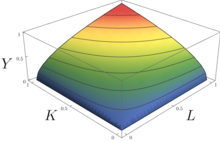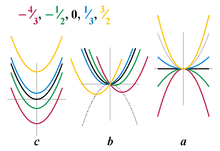Parametric family
This articleneeds additional citations forverification.(August 2021) |
Inmathematicsand its applications, aparametric familyor aparameterized familyis afamilyof objects (a set of related objects) whose differences depend only on the chosen values for a set ofparameters.[1]
Common examples are parametrized (families of)functions,probability distributions,curves, shapes, etc.[citation needed]
In probability and its applications[edit]

For example, the probability density functionfXof a random variableXmay depend on a parameterθ.In that case, the function may be denotedto indicate the dependence on the parameterθ.θis not a formal argument of the function as it is considered to be fixed. However, each different value of the parameter gives a different probability density function. Then theparametric familyof densities is the set of functions,whereΘdenotes theparameter space,the set of all possible values that the parameterθcan take. As an example, thenormal distributionis a family of similarly-shaped distributions parametrized by theirmeanand theirvariance.[2][3]
Indecision theory,two-moment decision modelscan be applied when the decision-maker is faced with random variables drawn from alocation-scale familyof probability distributions.[citation needed]
In algebra and its applications[edit]

Ineconomics,theCobb–Douglas production functionis a family ofproduction functionsparametrized by theelasticitiesof output with respect to the variousfactors of production.[citation needed]

Inalgebra,thequadratic equation,for example, is actually a family of equations parametrized by thecoefficientsof the variable and of its square and by theconstant term.[citation needed]
See also[edit]
References[edit]
- ^"All of Nonparametric Statistics".Springer Texts in Statistics.2006.doi:10.1007/0-387-30623-4.
- ^Mukhopadhyay, Nitis (2000).Probability and Statistical Inference.United States of America:Marcel Dekker, Inc.pp. 282–283, 341.ISBN0-8247-0379-0.
- ^"Parameter of a distribution".www.statlect.com.Retrieved2021-08-04.


